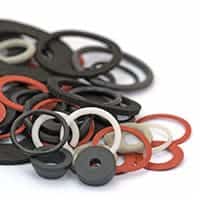O-rings are a critical component in the automotive industry. They create a secure seal between two surfaces, preventing leaks by keeping oil and other fluids well-contained. Automotive o-rings and seals can be produced from a wide range of materials to meet a variety of performance needs. In this blog, we will discuss the material options for automotive o-rings, selection considerations, and common applications.
What Types of Materials Are Used for Automotive O-Rings?
 O-rings are used in several automotive systems, each with its own environmental challenges. Proper material selection is critical for ensuring optimal performance in each application. Some of the most common materials for automotive o-rings include:
O-rings are used in several automotive systems, each with its own environmental challenges. Proper material selection is critical for ensuring optimal performance in each application. Some of the most common materials for automotive o-rings include:
Buna-Nitrile
Also known as Buna-N, this elastomer is widely used due to its excellent oil resistance and good chemical resistance. Buna-nitrile is suitable for environments between -40 °F to 250 °F (-40°C to 121°C), and it has a hardness range of 40 to 90 durometer. It is commonly used in applications such as fuel tanks and other automotive and aerospace-related applications.
EPDM
EPDM is a synthetic rubber providing excellent chemical resistance and heat resistance. It can operate at temperatures between -60 °F to 300 °F (-51 °C to 150 °C) and has a hardness range of 40-90 durometer. EPDM is a highly versatile material that’s used in automotive components in addition to medical devices, household appliances, and more.
Silicone
A non-reactive, stable synthetic rubber, silicone provides excellent heat and cold resistance and can also withstand ozone exposure and prevent fungal growth. It has a hardness range of 30-80 durometer and an operating temperature range of -75 °F to 450 °F(-60 °C to 232 °C). Silicone is most suitable for static applications and is a common material choice for everything from automotive components to medical devices, electronics, and much more.
Viton®/Fluorocarbon
This is a synthetic elastomer that provides excellent resistance to acids, heat, oils, weather, and flame. It has a hardness range of 50-95 durometer and an operating temperature range of -20 °F to 400 °F (-29 °C to 204 °C). Due to its excellent durability, fluorocarbon is used in demanding applications such as chemical processing and automotive equipment.
What Should You Look For in Automotive O-Rings?
There are many factors to consider when selecting the most suitable automotive o-ring. Firstly, many basic polymers aren’t compatible with fuels, oils, solvent-based compounds, and other substances commonly found in automotive environments. For this reason, it is essential to select a compatible material that is rugged enough to withstand the challenges of your application.
For example, o-rings that are used in high-performance or turbo engines require sturdy construction and a material durable enough to withstand high temperatures, pressure, and chemical exposure. Engine o-rings are specifically created from compatible hybrid materials that perform reliably under these challenging conditions.
When selecting an o-ring for any specific application, it’s important to consider factors such as:
- Operating conditions
- Chemical compatibility
- Durometer
- Tear resistance
- Sealing pressure
- Temperature compatibility
- Size
- Abrasion, ozone, and electrical resistance
- Cost
To ensure your o-ring is compatible with your application, you can perform field tests to ensure all performance requirements are met.
Applications of O-Rings in the Automotive Industry
Many automotive systems require o-rings to create secure seals and prevent leaks. The most common applications include breaking systems, lubricant circuits, and air conditioning systems.
Brake Circuits
As a crucial component of any automobile, brake systems need to perform reliably. O-rings used in brake circuits are exposed to glycol-based synthetic oil as well as extreme temperature and pressure variations. To withstand these conditions, materials with a rubber EPDM Perox base are commonly recommended.
Lubricant Circuits
Engines and transmission components are lubricated with mineral oils that feature other additives, like antifoaming agents. Depending on the specific usage, the fluid temperature varies. Some of the most commonly used materials for o-rings in lubricant circuits include NBR, ACM, and FPM.
Air Conditioning Systems
Automotive air conditioning systems require o-rings to help contain gaseous fluids at different temperatures and state variations. In these applications, o-rings ensure components remain in their designated areas, without flowing into areas they’re not supposed to.
Automotive O-Rings From Fournier Rubber & Supply Co.
Fournier Rubber & Supply Co. has fabricated reliable custom rubber products since 1933. We use a diverse selection of elastomers to create o-rings that adhere to the automotive industry’s rigorous demands. To learn more about our o-rings for automotive applications, contact our team today or request a quote to get started on your solution.





